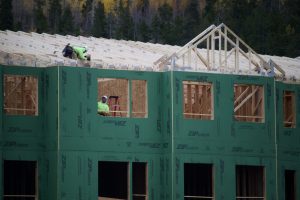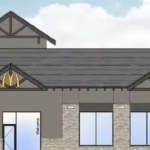Will Colorado’s new construction defects law bring more starter homes to ski towns? Housing experts are cautiously hopeful.
Builders and policy wonks say high exposure to litigation has stymied affordable condo development. A new law is trying to change that.

Ryan Spencer/Summit Daily News
Editor’s note: This story was updated to correct the spelling of Peter LiFari’s last name and the room where Kathy Eckert discovered flooding due to a construction defect.
When a Colorado think tank released a report in 2023 on the landscape of the state’s condominium market, policymakers were floored.
It showed an 84% decrease in the number of active condo developers over the last 15 years, going from 146 in 2007 to 23 in 2022. Today, Colorado Homebuilders Association CEO Ted Leighty believes the number is even smaller.
He says condo developers’ elevated exposure to litigation is the reason.
“The folks that I represent, who have continued to build condominiums, continue to get sued,” Leighty said. “I know of builders who are doing condos right now who won’t do another one once it’s completed.”
It’s why Colorado lawmakers this past legislative session passed the most significant reform to the state’s construction defects laws in years. Beginning in January 2026, condo developers will be able to opt into a program that aims to provide them with more immunity from lawsuits, so long as they take steps to ensure their builds are up to par.
Lawmakers hope the measure will revive the state’s condo market, historically seen as the entry point into housing for first-time homebuyers. In high-cost mountain towns, where average housing costs hover in the millions, legislators say more affordable development is urgently needed to ensure there is a sustainable and thriving workforce.
“There are teachers, police officers, small business owners, nurses, and other crucial working folks who desperately want to be able to buy a home and put roots down, but there’s not any housing available for them to purchase,” said Sen. Dylan Roberts, a Frisco Democrat and a prime sponsor of this year’s construction defects law, in a news release last month promoting the legislation.
Stay up-to-date on all things housing, development, real estate and short-term rentals with a weekly newsletter.
Sign up here: SummitDaily.com/newsletter
Roberts added that the new reforms will “help ensure that we have a healthy mix of housing units, allowing more Coloradans to achieve their dream of homeownership.”
For Leighty, the measure could be a turning point after years of stifled affordable condo development. But he’s not expecting a quick fix.
“I think it’s probably going to be slow to adopt,” he said. “It could still take several years before we see this kind of production ramp up again.”
Why market impacts could take time
For builders to be incentivized to jump back into the condo market en masse, they’ll need to see their risk reduction reflected in their insurance costs, Leighty said.
A sweeping 2023 study by the Common Sense Institute, a Colorado-based, conservative-backed think tank that promotes economic policy, found that insurance costs for condo developments were 233% higher than the cost of building single-family homes.
The report, which is the same one that identified the 84% decrease in condo builders, shows that insurance for a condo project can cost 5% to 5.5% of the development’s overall cost, while for single-family homes, it ranges from 1.1% to 1.65%. The report attributes the difference to the highly litigious nature of condo construction.
State law gives homeowners up to six years after the “substantial completion” of a project to file a construction defect claim, though in some cases that can be extended to eight years if a defect is discovered in the fifth or sixth year.
Leighty said most claims are usually made toward the end of that window, meaning even with the state’s new reform program, it could be six to eight years before builders start seeing the benefit of less litigation reflected in their insurance costs.
If insurance costs do ultimately drop, Leighty said it could help spur a resurgence in condo development, particularly those seen as entry-level housing. If developers have lower construction costs to pass onto the buyer, it could make for more affordable price points.
“Building a for-sale entry-level product is fast becoming non-existent,” Leighty said. “The best way we can do that is by building with greater density on less land. This bill is a good step in the right direction.”

Lower costs may still be more difficult, however, to achieve in the high country compared to the Front Range. A shorter building season, a limited labor force and higher cost of land make the margins for developers that much tighter.
Still, Leighty believes any efforts to help lower costs for more developers will help generate more housing, not just luxury homes.
“I do think yes, that if you effectively reform this issue, you could see more workforce-oriented or entry-level projects enter into the market both in the high country and down here in the Front Range,” he said.
It will also take enough builders signing up for the program to move the needle. Leighty predicts smaller, entrepreneurial companies will be among the first ones out of the gate as larger building firms wait to see how the program plays out and what its effects are.
Leighty said the builder’s association is recommending developers speak with their insurers and trade partners to understand what the program will mean for them before jumping in. But he remains “cautiously optimistic” that the new reforms will be attractive to builders.
Change to HOA’s lawsuit powers could be key
The reforms passed by lawmakers in 2025 represent the culmination of years of efforts to make condo development a friendly space for builders by lowering the risk of litigation.
For builders who opt into the voluntary program, they are required to have a third-party inspector check up on the home throughout the construction process and must provide warranties for homeowners for different aspects of the home, ranging from one year for workmanship to six years for major structural components.
In exchange, builders will be given more legal protection and ways to avoid litigation, such as the right to fix defects before homeowners can file a lawsuit.
Homeowners can still pursue lawsuits under certain scenarios, such as when a home is unsafe, but they would be required to first work with the builder to try and fix the issue and show that they took steps themselves to mitigate problems from becoming worse.
Perhaps the single most impactful change, policy experts say, is raising the threshold needed for homeowners’ associations to file lawsuits. HOAs will no longer be able to initiate a lawsuit against a developer with just a simple majority vote from their members. Instead, they’ll need at least 65% of members to vote in favor of a suit.

Peter LiFari, housing fellow at the Common Sense Institute and the author of the 2023 construction defects report, said the ease with which HOAs can launch lawsuits is a major contributing factor to why condo development faces more legal risk than other types of housing.
Since HOAs represent multiple homeowners, they can effectively file lawsuits that mimic class action cases, LiFari said. As of 2023, roughly 2.7 million Coloradans lived under an HOA, representing about half the state’s population.
“It is very lucrative to engage in a class action expedition that could be born out of a legitimate defect,” LiFari said, adding that many condo developments, most of which are overseen by HOAs, end up facing some form of litigation directed at the builder.
While LiFari said construction defects are a legitimate issue, builders and homeowners need to have other methods for reconciling problems that avoid drawn-out and costly legal battles.
Policy can be one way to initiate change, but LiFari said there must also be a cultural shift in the relationship between communities and home developers if more housing is to be built.
“One of the reasons we have a debate around construction defects is this cultural standard that ‘homebuilders are not to be trusted,’ and homes are negative externalities that need to be highly regulated,” LiFari said.
Striking a balance between homeowner and builder protections
Builders aren’t the only ones eager to see how the state’s reforms will play out. Homeowners are still questioning what the changes will mean for them.
Those who’ve lived with construction defects say the impact of a faulty home can be devastating.
“It’s brutal from an emotional standpoint, and also financially,” said Kathy Eckert, who went through a years-long legal battle with a builder after she discovered her single-family home in Fraser was riddled with issues.
Eckert thought she was getting her dream house in the mountains after her two-bedroom, 2.5-bathroom home was finished in 2017. But a couple of months after moving in, she noticed flooding in the garage, the result of poor slab grading.
Soon, more issues began to reveal themselves, including an improperly attached back deck and black mold in the basement due to a damp subfloor, which Eckert believes caused a now chronic health issue for which she has to take medication.
“It became clear that this needed to be dealt with through the legal system,” Eckert said of her lawsuit, which she said ended up costing her tens of thousands of dollars in legal fees.
Eckert’s experience is why she joined a coalition of homeowners this year who advocated for more consumer protections as this year’s construction defects bill was being drafted.
While Eckert said it’s important for builders to be able to develop more starter homes, especially in mountain communities, they need to be built right.
She said she’s reassured by some of the new law’s provisions, like the requirement for third-party inspections, but added, “We’re not going to know the impact until it’s really implemented.”
And to what extent the measure will result in more starter homes in the high country, industry leaders say it’s unclear. Along with the higher cost of building, rural resort areas also see unique market trends, including demand for luxury properties, that are all but certain to keep the cost of housing high.
Still, it’s important for policymakers to ask, “What incentives can we give to builders to build those smaller, more affordable properties?” said Dana Cottrell, president of the Colorado Association of Realtors and a longtime broker in the mountains.
“The more we can encourage, the more we can put that carrot out there for builders, I think it’s just a good thing,” she said.

Support Local Journalism

Support Local Journalism
As a Summit Daily News reader, you make our work possible.
Summit Daily is embarking on a multiyear project to digitize its archives going back to 1989 and make them available to the public in partnership with the Colorado Historic Newspapers Collection. The full project is expected to cost about $165,000. All donations made in 2023 will go directly toward this project.
Every contribution, no matter the size, will make a difference.










